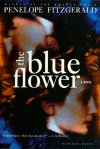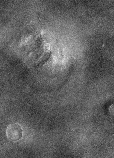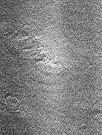
 |
FEATURES
|
Mars Face Newly released photographs from the Mars Global Surveyor appear to debunk the so-called 'Face on Mars', a feature seen in a 1976 Viking image that some have claimed as evidence of intelligent life.
The 1976 image of the Cydonia region on Mars (left) shows a hill with a starkly contrasting pattern of light and shadow resembling a human face. A number of books and articles published over the years have claimed to find evidence of alien artifacts or lost civilizations in geometrical analysis of the face's shape and its position relative to surrounding hills. (Occasional Analog contributor Richard C. Hoagland published an article there in Nov. 1986, ''The Curious Case of the Humanoid Face... on Mars'', and published a book that year, The Monuments of Mars: A City on the Edge of Forever.) The face image has become familiar from supermarket tabloid covers, and even appeared in an X-Files episode. Most scientists have dismissed the facial resemblance as the chance effect of oblique illumination on natural features, an interpretation supported by the new photos (center and right). Some face proponents have dabbled in conspiracy theory, suggesting that the 1993 Mars Observer spacecraft, which failed on approach to Mars, was deliberately scuttled to keep further evidence of artificial structures on Mars hidden. To deflect such charges, JPL took the unusual step of posting the raw data to the internet as it was received Monday morning (April 6th). Predictably, theorists like Hoagland are unmoved by the new photos; Tuesday's Los Angeles Times reports that Hoagland considers them of too poor quality to draw any conclusions. NASA is taking no official position on what the images show, leaving any interpretation to the scientific community. The same area of Mars is scheduled to be photographed further by the Global Surveyor April 14th and 23rd. Links: CNN article; JPL's Mars news site; the full-sized 1976 Viking photograph showing the 'Face on Mars'; the Mars Global Surveyor raw images containing the new Cydonia pictures. Y2K  You've heard of the Year 2000 Crisis -- the potential for computers to wreak havoc one minute past midnight of December 31, 1999, when software written decades ago using only two digits to represent years no longer works properly. (It's also referred to as the 'millennium bug'.) The issue has been subject of the usual pendulum coverage in the press -- alarmist articles followed by debunking articles and back again. Edward Yourdon, a long-time software engineering guru and consultant, has published a book on the subject, Time Bomb 2000. Last month he was interviewed in Salon, where he outlined his reasons for thinking the impact of the crisis will be substantial. Yourdon makes the worrisome point that even if most computer software is brought up to speed in time, our technological infrastructure is so interconnected that the remaining handful of broken systems could bring the others down. Yourdon's acts certainly speak for his words: he's gotten out of the stock market and moved his family from New York to New Mexico.
You've heard of the Year 2000 Crisis -- the potential for computers to wreak havoc one minute past midnight of December 31, 1999, when software written decades ago using only two digits to represent years no longer works properly. (It's also referred to as the 'millennium bug'.) The issue has been subject of the usual pendulum coverage in the press -- alarmist articles followed by debunking articles and back again. Edward Yourdon, a long-time software engineering guru and consultant, has published a book on the subject, Time Bomb 2000. Last month he was interviewed in Salon, where he outlined his reasons for thinking the impact of the crisis will be substantial. Yourdon makes the worrisome point that even if most computer software is brought up to speed in time, our technological infrastructure is so interconnected that the remaining handful of broken systems could bring the others down. Yourdon's acts certainly speak for his words: he's gotten out of the stock market and moved his family from New York to New Mexico.
Haiku Error Messages Have you received email recently containing a set of amusing haiku error messages? You know, error messages from your computer about losing files or needing to reboot in the form of haiku, e.g. Three things are certain:This round of net lore originated with an online contest hosted by Salon back in January. The results were posted in February. Subsequently, enterprising email mavens copied the list of winners -- and removed the winning authors' names -- and spammed them around the net. Salon published a follow-up article about this latest example of how information wants to be free, remarking upon the apparently needless effort someone went to make the information anonymous as well. An illustrative lesson, perhaps, for any writer who posts work on the web. (The example above is the winning entry by David Dixon.) NBCC Winners  On March 24th winners were announced for the 1997 National Book Critics Circle awards. The most notable winner was in the fiction category, where British author Penelope Fitzgerald won for her novel The Blue Flower. Hers was an upset victory in a category dominated by heavy-weights Don DeLillo (Underworld), Philip Roth (American Pastoral), and Charles Frazier (Cold Mountain). The result was controversial for two reasons: there were reports that Fitzgerald was a compromise choice among judges split between DeLillo and Roth; and because Fitzgerald is non-American, in this first year the NBCC awards were open to foreign writers.
On March 24th winners were announced for the 1997 National Book Critics Circle awards. The most notable winner was in the fiction category, where British author Penelope Fitzgerald won for her novel The Blue Flower. Hers was an upset victory in a category dominated by heavy-weights Don DeLillo (Underworld), Philip Roth (American Pastoral), and Charles Frazier (Cold Mountain). The result was controversial for two reasons: there were reports that Fitzgerald was a compromise choice among judges split between DeLillo and Roth; and because Fitzgerald is non-American, in this first year the NBCC awards were open to foreign writers.
The full list of winners is available on the NBCC website. The NBCC consists of some 650 critics and editors. There is no cash prize with the awards.  LA Times Book Prizes
LA Times Book PrizesWinners of the Los Angeles Times Book Prizes were announced in late February, in advance of an awards ceremony scheduled for April 24th. They included, in the Fiction category, James Carlos Blake for In the Rogue Blood and, in the Science and Technology category, Steven Pinker's How the Mind Works. Each LA Times prize comes with a $1000 cash award. The full list of winners is here. Pi Day We're late in posting this, but March 14th was Pi Day. Actually, Pi Day ceremonies take place -- perhaps you can anticipate this -- on March 14th at 1:59 p.m. That's because the transcendental number pi, the ratio of a circle's circumference to its diameter, is 3.14159... and so on.
A recent book, The Joy of Pi by David Blatner, compiles pi-related trivia, anecdotes, and history. Included are a passage from Carl Sagan's Contact about finding a message in eleven dimensions deep inside pi; the transcript of an interchange about pi from the O. J. Simpson trial; lots of good mathematical stuff; and, for handy reference, the first one million digits of pi spread through the margins and endpapers of the book. How to Formulate a Bestseller  An article in the March 1st New York Times Magazine describes the efforts of two men to manufacture a bestseller. John Baldwin, author of two previous novels currently making his living as a carpenter, and Dr. John S. Marr, an epidemiologist, heard that Robin Cook planned his 1977 medical thriller Coma by studying the characteristics of 100 bestselling novels. So Baldwin and Marr studied Coma, checked it against some Tom Clancy novels, and derived a 10-point formula for writing a bestseller. Among the points:
An article in the March 1st New York Times Magazine describes the efforts of two men to manufacture a bestseller. John Baldwin, author of two previous novels currently making his living as a carpenter, and Dr. John S. Marr, an epidemiologist, heard that Robin Cook planned his 1977 medical thriller Coma by studying the characteristics of 100 bestselling novels. So Baldwin and Marr studied Coma, checked it against some Tom Clancy novels, and derived a 10-point formula for writing a bestseller. Among the points:
1) The hero is an expertTheir result is a book called The Eleventh Plague, about a bioterrorist who sets out to recreate the biblical 10 plagues of Egypt in modern day US. (It's also important to be able to summarize the book's premise in one line.) It sold at auction to HarperCollins for a rights package worth $3 million, and was published a couple months ago. Has it made the bestseller lists? Not that we've noticed. (We did notice however that a reviewer for SF Site was quite pleased with the book.) Oh really? Roger Ebert's review of the film version of Michael Crichton's novel Sphere opens with the following lines: Michael Crichton is the science-fiction author that people read if they think they're too good for ''regular'' science fiction. Too bad. What they get in the film version of ''Sphere,'' directed by Barry Levinson, is a watered-down take on the sci-fi classic Solaris, by Stanislaw Lem, which was made into an immeasurably better film by Andrei Tarkovsky.
|
|||||||||||||
| TOP |
| © 1998 by Locus Publications. All rights reserved. |



 Other honors included a lifetime achievement award to Leslie Fiedler, author of critical works including Love and Death in the American Novel (1960). Fiedler's interest occasionally extends to science fiction: he published an anthology In Dreams Awake in 1975, and a book about Olaf Stapledon in 1983.
Other honors included a lifetime achievement award to Leslie Fiedler, author of critical works including Love and Death in the American Novel (1960). Fiedler's interest occasionally extends to science fiction: he published an anthology In Dreams Awake in 1975, and a book about Olaf Stapledon in 1983.
